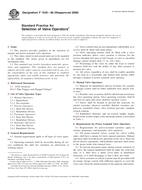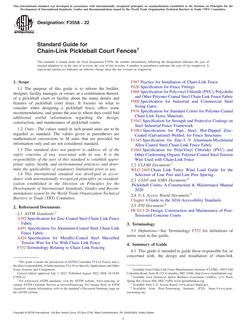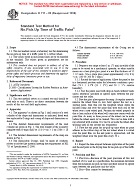1.1 This test method covers the evaluation of automotive engine oils (SAE grades 5W, 10W, 20, 30, 40, and 50, and multiviscosity grades) intended for use in spark-ignition gasoline engines. The test procedure is conducted using a carbureted, spark-ignition Cooperative Lubrication Research (CLR) Oil Test Engine (also referred to as the Sequence VIII test engine in this test method) run on unleaded fuel. An oil is evaluated for its ability to protect the engine and the oil from deterioration under high-temperature and severe service conditions. The test method can also be used to evaluate the viscosity stability of multiviscosity-graded oils. Companion test methods used to evaluate engine oil performance for specification requirements are discussed in the latest revision of Specification D4485.
1.2 Correlation of test results with those obtained in automotive service has not been established. Furthermore, the results obtained in this test are not necessarily indicative of results that will be obtained in a full-scale automotive spark-ignition or compression-ignition engine, or in an engine operated under conditions different from those of the test. The test can be used to compare one oil with another.
1.3 The values stated in SI units are to be regarded as standard. No other units of measurement are included in this standard.
1.3.1 Exceptions – The values stated in inch-pounds for certain tube measurements, screw thread specifications, and sole source supply equipment are to be regarded as standard.
1.4 This standard does not purport to address all of the safety concerns, if any, associated with its use. It is the responsibility of the user of this standard to establish appropriate safety and health practices and determine the applicability of regulatory limitations prior to use. Specific precautionary statements are provided throughout this test method.
1.5 This test method is arranged as follows:
| Subject | Section | |
| Introduction | ||
| Scope | 1 | |
| Referenced Documents | 2 | |
| Terminology | 3 | |
| Summary of Test Method | 4 | |
| Before Test Starts | 4.1 | |
| Power Section Installation | 4.2 | |
| Engine Operation (Break-in) | 4.3 | |
| Engine Operation (Test/Samples) | 4.4 | |
| Stripped Viscosity | 4.5 | |
| Test Completion (BWL) | 4.6 | |
| Significance and Use | 5 | |
| Evaluation of Automotive oils | 5.1 | |
| Stay in Grade Capabilities | 5.2 | |
| Correlation of Results | 5.3 | |
| Use | 5.4 | |
| Apparatus | 6 | |
| Test Engineering, Inc. | 6.1 | |
| Fabricated or Specially Prepared Items | 6.2 | |
| Instruments and Controls | 6.3 | |
| Procurement of Parts | 6.4 | |
| Reagents and Materials | 7 | |
| Reagents | 7.1 | |
| Cleaning Materials | 7.2 | |
| Expendable Power Section-Related Items | 7.3 | |
| Power Section Coolant | 7.4 | |
| Reference Oils | 7.5 | |
| Test Fuel | 7.6 | |
| Test Oil Sample Requirements | 8 | |
| Selection | 8.1 | |
| Inspection | 8.2 | |
| Quantity | 8.3 | |
| Preparation of Apparatus | 9 | |
| Test Stand Preparation | 9.1 | |
| Conditioning Test Run on Power Section | 9.2 | |
| General Power Section Rebuild Instructions | 9.3 | |
| Reconditioning of Power Section After Each Test | 9.4 | |
| Calibration | 10 | |
| Power Section and Test Stand Calibration | 10.1 | |
| Instrumentation Calibration | 10.2 | |
| Calibration of AFR Measurement Equipment | 10.3 | |
| Calibration of Torque Wrenches | 10.4 | |
| Engine Operating Procedure | 11 | |
| Run-In and Flush | 11.1 | |
| Test Operating Conditions | 11.2 | |
| Air-Fuel Ratio and Spark Advance | 11.3 | |
| Air, Off-Gas and Blowby Measurement | 11.4 | |
| Unscheduled Shutdowns | 11.5 | |
| Oil Sampling and Oil Addition | 11.6 | |
| Periodic Measurements | 11.7 | |
| Final Oil Drain and Oil Consumption Computation | 11.8 | |
| Operational Validity Criteria | 11.9 | |
| Test Completion | 11.10 | |
| Determination of Test Results | 12 | |
| Oil Analysis | 12.1 | |
| Test Bearing Weight Loss Determination | 12.2 | |
| Report | 14 | |
| Precision and Bias | 15 | |
| Precision | 15.1 | |
| Bias | 15.2 | |
| Use of ASTM Rounding | 16 | |
| Keywords | 17 | |
| ANNEXES | ||
| Measurement of Connecting Rod Bearing Clearance and Journal Taper |
Annex A1 | |
| Measurement of Main Bearing Clearance | Annex A2 | |
| The ASTM Test Monitoring Center Calibration Program | Annex A3 | |
| Measurement of Piston-to-Sleeve Clearance | Annex A4 | |
| Control Chart Technique for a Laboratory’s Severity Adjustment (SA) |
Annex A5 | |
| Recommended New Liner Honing Procedure | Annex A6 | |
| Sequence VIII Oil Priming Procedure | Annex A7 | |
| Alternative Crankcase Breather Configuration | Annex A8 | |
| Connecting Rod Bearing Cleaning Procedure | Annex A9 | |
| Electronic Ignition Conversion | Annex A10 | |
| System Response Procedure | Annex A11 | |
| Air-Fuel Ratio Measurement | Annex A12 | |
| Lead Decontamination Procedure | Annex A13 | |
| Stay-in-Grade Oil Analysis Procedure | Annex A14 | |
| Crankshaft Rear Seal Conditioning | Annex A15 | |
| Report Forms and Data Dictionary | Annex A16 | |
| Test Fuel Specification | Annex A17 | |
| APPENDIXES | ||
| Role of the ASTM Test Monitoring Center and the Calibration Program | Appendix X1 | |
| Suggested Method for Salvaging Camshaft Bearing Journals | Appendix X2 | |
| Data Log Sheets | Appendix X3 | |
Product Details
- Published:
- 10/01/2009
- Number of Pages:
- 39
- File Size:
- 1 file , 610 KB
- Redline File Size:
- 2 files , 1 MB


